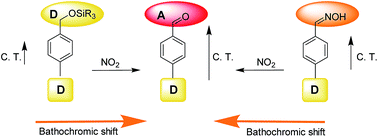Biphenyl derivatives containing trimethylsilyl benzyl ether or oxime groups as probes for NO2 detection†
Abstract
Four probes based in the use of a biphenyl moiety and functionalized with trimethylsilyl benzyl ether (P1 and P3) and oxime (P2 and P4) groups have been prepared and tested as optical probes for the detection of NO2. Reaction of NO2 with acetonitrile solutions of P2–P4 resulted in the formation of aldehydes 7 and 8 with a concomitant redshift of the absorption bands. Probe P2 displayed a bathochromic shift of 45 nm upon reaction with NO2 and was able to detect this poisonous gas at concentrations as low as 0.02 ppm. P2 was highly selective against NO2 and other gases (i.e. NO, CO2, H2S, SO2) and vapours of organic solvents (i.e. acetone, hexane, chloroform, acetonitrile or toluene) had no effect in the optical properties of the probe.


 Please wait while we load your content...
Please wait while we load your content...